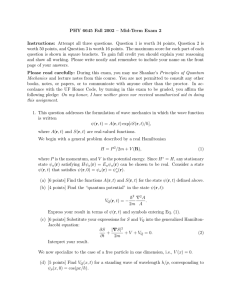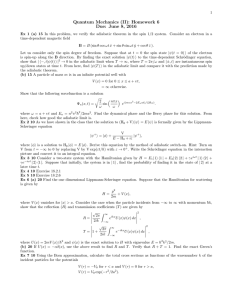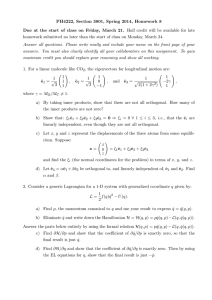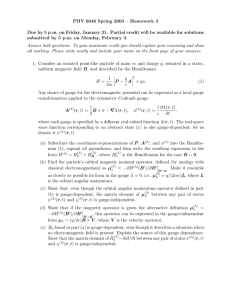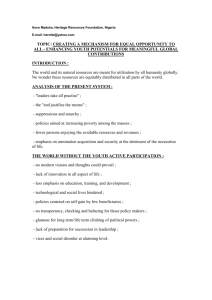Lecture 19 Relevant sections in text: §2.6
advertisement
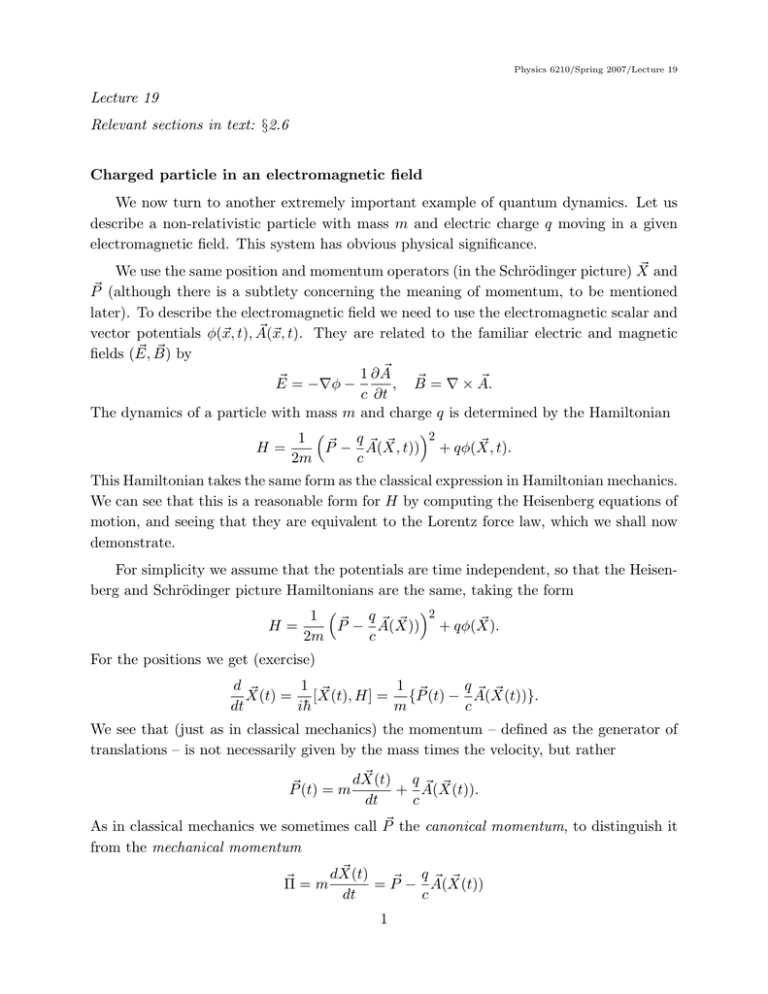
Physics 6210/Spring 2007/Lecture 19
Lecture 19
Relevant sections in text: §2.6
Charged particle in an electromagnetic field
We now turn to another extremely important example of quantum dynamics. Let us
describe a non-relativistic particle with mass m and electric charge q moving in a given
electromagnetic field. This system has obvious physical significance.
~ and
We use the same position and momentum operators (in the Schrödinger picture) X
P~ (although there is a subtlety concerning the meaning of momentum, to be mentioned
later). To describe the electromagnetic field we need to use the electromagnetic scalar and
~ x, t). They are related to the familiar electric and magnetic
vector potentials φ(~x, t), A(~
~ B)
~ by
fields (E,
~
~ = ∇ × A.
~
~ = −∇φ − 1 ∂ A , B
E
c ∂t
The dynamics of a particle with mass m and charge q is determined by the Hamiltonian
2
1 ~ q ~ ~
~ t).
H=
P − A(X, t)) + qφ(X,
2m
c
This Hamiltonian takes the same form as the classical expression in Hamiltonian mechanics.
We can see that this is a reasonable form for H by computing the Heisenberg equations of
motion, and seeing that they are equivalent to the Lorentz force law, which we shall now
demonstrate.
For simplicity we assume that the potentials are time independent, so that the Heisenberg and Schrödinger picture Hamiltonians are the same, taking the form
1 ~ q ~ ~ 2
~
H=
P − A(X)) + qφ(X).
2m
c
For the positions we get (exercise)
1 ~
1
q~ ~
d ~
X(t) = [X(t),
X(t))}.
H] = {P~ (t) − A(
dt
ih̄
m
c
We see that (just as in classical mechanics) the momentum – defined as the generator of
translations – is not necessarily given by the mass times the velocity, but rather
~
dX(t)
q~ ~
X(t)).
P~ (t) = m
+ A(
dt
c
As in classical mechanics we sometimes call P~ the canonical momentum, to distinguish it
from the mechanical momentum
~
~ = m dX(t) = P~ − q A(
~ X(t))
~
Π
dt
c
1
Physics 6210/Spring 2007/Lecture 19
Note that the mechanical momentum has a direct physical meaning, while the canonical
momentum depends upon the non-unique form of the potentials. We will discuss this in
detail soon.
While the components of the canonical momenta are compatible,
[Pi , Pj ] = 0,
the mechanical momenta are not (!):
∂Aj
q ∂A
q
) = ih̄ ijk B k .
[Πi , Πj ] = ih̄ ( ji −
i
c ∂x
c
∂x
Thus, in the presence of a magnetic field, the mechanical momenta obey an uncertainty
relation! This is a surprising, non-trivial and quite robust prediction of quantum mechanics. In particular, if the field is uniform, then two components of mechanical momentum
will obey a state independent uncertainty relation rather like ordinary position and momentum. Can this prediction be verified? As you will see in your homework problems, this
incompatibility of the mechanical momentum components in the presence of a magnetic
field is responsible for the “Landau levels” for the energy of a charged particle in a uniform
magnetic field. These levels are well-known in condensed matter physics.
The remaining set of Heisenberg equations are most simply expressed using the mechanical momentum. Starting with
H=
Π2
~
+ qφ(X),
2m
using the commutation relations between components of the mechanical momentum (above),
and using
[X i , Πj ] = ih̄δji I,
we have (exercise)
d~
1 ~
1
~ X(t))
~
~
~ X(t))
~
~ X(t))
~
~
Π(t) = [Π(t), H] = q E(
+
Π(t)
× B(
− B(
× Π(t)
.
dt
ih̄
2mc
~ and B,
~ this is the usual Lorentz force law
Except for the possible non-commutativity of Π
for the operator observables.
The Schrödinger equation
Dynamics in the Schrödinger picture is controlled by the Schrödinger equation. If we
compute it for position wave functions then we get (exercise)
2
1
h̄
q~
∂
∇ − A(~x) ψ(~x, t) + qφ(~x, t)ψ(~x, t) = ih̄ ψ(~x, t).
2m i
c
∂t
2
Physics 6210/Spring 2007/Lecture 19
The left hand side represents the action of the Hamiltonian as a linear operator on position
wave functions. We have in detail
qh̄ ~
1
q 2 2
h̄2 2
~
∇ ψ−
A · ∇ψ + (∇ · A)ψ + [
A + qφ]ψ.
Hψ = −
2m
imc
2
c
As you may know, one can always arrange (by making a gauge transformation if
necessary) to use a vector potential that satisfies the “Coulomb gauge”:
~ = 0.
∇·A
In this case the Hamiltonian on position wave functions takes the form
Hψ = −
q 2
h̄2 2
qh̄ ~
∇ ψ−
A · ∇ψ + [
A2 + qφ]ψ.
2m
imc
c
Some typical electromagnetic potentials that are considered are the following.
(i) The Coulomb field, with
φ=
k
,
|~x|
~ = 0,
A
which features in a simple model of the hydrogen atom; the spectrum and stationary states
should be familiar to you. We will soon study it a bit in the context of angular momentum
issues.
~ where
(ii) A uniform magnetic field B,
φ = 0,
~ = 1 B × ~x.
A
2
The vector potential is not unique, of course. This potential is in the Coulomb gauge. You
will explore this system in your homework. The results for the stationary states are interesting. One has a continuous spectrum coming from the motion along the magnetic field;
but for a given momentum value there is a discrete spectrum of “Landau levels” coming
~ To see this one massages the Hamiltonian into
from motion in the plane orthogonal to B.
the mathematical form of a free particle in one dimension added to a harmonic oscillator;
this is the gist of your homework problem.
(iii) An electromagnetic plane wave, in which
φ = 0,
~=A
~ 0 cos(~k · ~x − kct),
A
~k · A
~ 0 = 0.
Of course, this latter example involves a time dependent potential. This potential is used
to study the very important issue of interaction of atoms with a radiation field; maybe we
will have time to study this toward the end of the semester.
3
Physics 6210/Spring 2007/Lecture 19
Gauge transformations
There is a subtle issue lurking behind the scenes of our model of a charged particle in
a prescribed EM field. It has to do with the explicit appearance of the potentials in the
operators representing various observables. For example, the Hamiltonian – which should
represent the energy of the particle – depends quite strongly on the form of the potentials.
The issue is that there is a lot of mathematical ambiguity in the form of the potentials
and hence operators like the Hamiltonian are not uniquely defined. Let me spell out the
source of this ambiguity.
~ define a given EM
You may recall from your studies of electrodynamics that, if (φ, A)
~ B),
~ then the potentials (φ0 , A
~ 0 ), given by
field (E,
φ0 = φ −
1 ∂f
,
c ∂t
~0 = A
~ + ∇f,
A
~ B)
~ for any choice of f = f (t, ~x). Because all the physics in classical
define the same (E,
~ and B,
~ we declare that all potentials related by such
electrodynamics is determined by E
gauge transformations are physically equivalent in the classical setting. In the quantum
setting, we must likewise insist that this gauge ambiguity of the potentials does not affect
physically measurable quantities. Both the Hamiltonian and the mechanical momentum
are represented by operators which change their mathematical form when gauge-equivalent
potentials are used. The issue is how to guarantee the physical predictions are nonetheless
gauge invariant.
Let us focus on the Hamiltonian for the moment. The eigenvalues of H define the
allowed energies; the expansion of a state vector in the eigenvectors of H defines the
probability distribution for energy; and the Hamiltonian defines the time evolution of the
system. The question arises whether or not these physical aspects of the Hamiltonian
operator are in fact influenced by a gauge transformation of the potentials. If so, this
would be a Very Bad Thing. Fortunately, as we shall now show our model for a particle in
an EM field can be completed so that the physical output of quantum mechanics (spectra,
probabilities) are unaffected by gauge transformations.
For simplicity (only) we still assume that H is time-independent and we only consider
gauge transformations for which ∂f
∂t = 0. The key observation is the following. Consider
two charged particle Hamiltonians H and H 0 differing only by a gauge transformation of
the potentials, so that they should be physically equivalent. Our notation is that if H is
~ then H 0 is defined by the gauge transformed potentials
defined by (φ, A)
φ0 = φ,
~0 = A
~ + ∇f (~x),
A
It is now straightforward to verify (see below) that if |Ei satisfies
H|Ei = E|Ei,
4
Physics 6210/Spring 2007/Lecture 19
then
iq
~
|Ei0 = e h̄c f (X) |Ei
satisfies
H 0 |Ei0 = E|Ei0 .
iq
~
Note that the eigenvalue is the same in each case. The operator e h̄c f (X) is unitary, and
this implies the spectra of H and H 0 are identical. Thus one can say that the spectrum of
the Hamiltonian is unaffected by a gauge transformation, that is, the spectrum is gauge invariant. Thus one can use whatever potentials one wishes to compute the energy spectrum
and the prediction is always the same.
To be continued. . .
5

